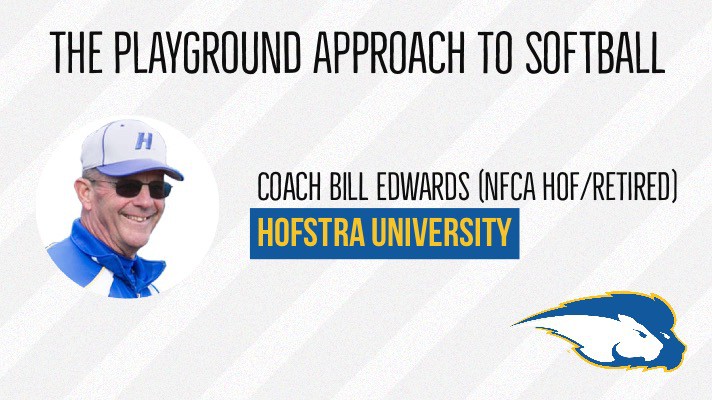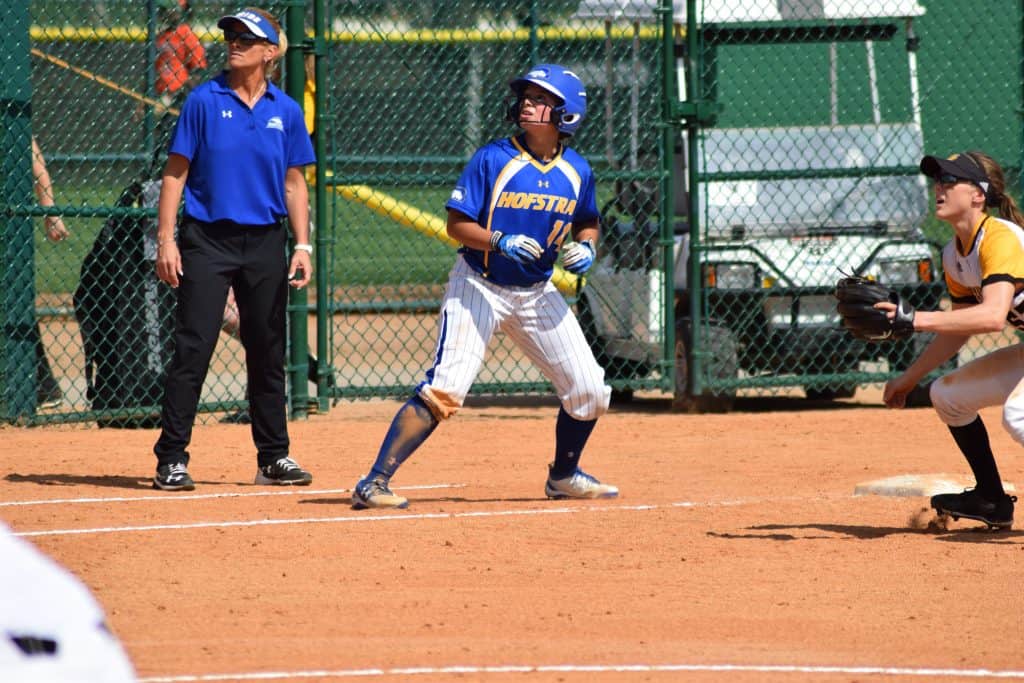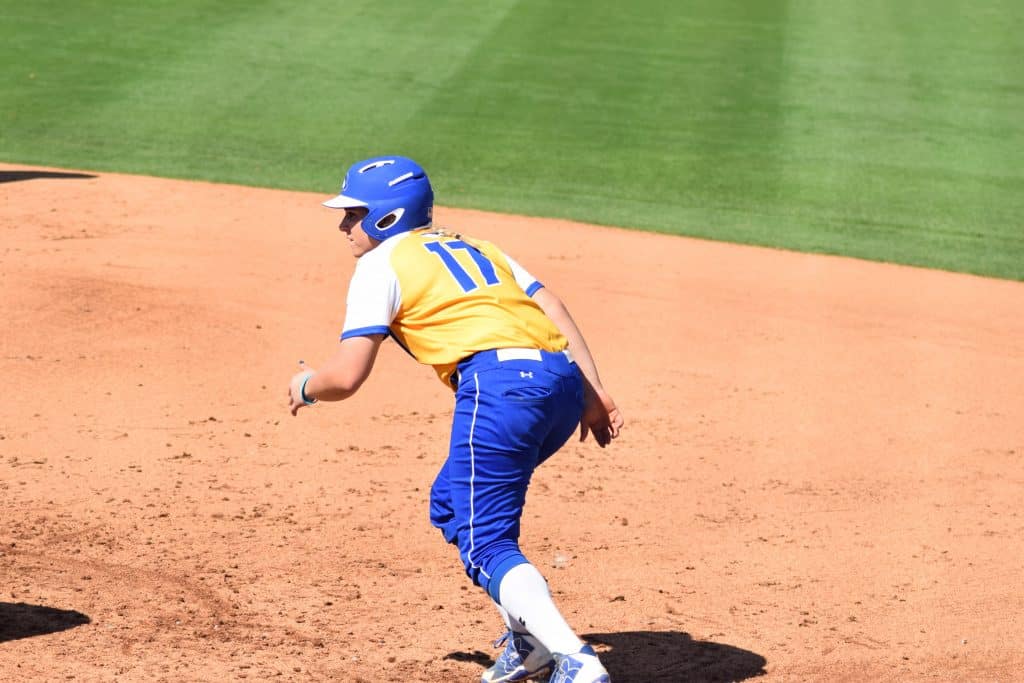
The Playground Approach to Softball by Bill Edwards
There was a time when the local playground helped shape a generation.
There was a freedom to those times, since we could leave our houses on a sunny summer day and meet at the playground for a day-long “game.” There was no adult supervision and the primary goal for some of us was to just get in the game. The older kids owned the field, and they chose the teams. And you had to pay your dues until you grew up to be an older kid, and then you “owned” the field. There was a right of passage.
Today’s generation of softball players doesn’t have those memories. As long as they can remember, they’ve been going to organized practices where adults coordinated every move. Sure, they learned some skills, but did they really learn how to PLAY the game, how to LOVE the game, how to JUST WANT TO BE IN THE GAME?
As part of my coaching philosophy, I’ve tried to give my players a taste of those days and the lifelong lessons learned from the experience. I’ve developed a whole defensive system and philosophy that I call “The Playground Approach.” It teaches what softball used to be, and what it still should be today.
The players must learn to play freely, relaxed, and most importantly, how to figure things out for themselves. There are certain things in our game that cannot be orchestrated, and we have to teach our players the lessons that the playground taught us. We also have to teach them why we play this game.
Winning then becomes the bi-product of all those lifelong lessons that we’re trying to teach. Everything that happens in a game, happens in life. You’re going to face adversity, deal with failure, all of the intangibles that we should be teaching the player at a very early age. So, before we discuss how to implement this philosophy, let’s look at what the playground has taught us.
- Right of Passage. The older kids ruled the field.
- How To Choose Up Sides. I distinctly remember sitting on the fence in the fifth grade, and the 7th and 8th graders were picking the teams. All I wanted to do was get in the game. I was hoping they would choose me. I’m the youngest kid there and I’m the last one picked. I came flying off the fence, yelling “I’m in the game, I’m in the game.” My self-esteem was so high, because it wasn’t about being the last one picked; it was about being in the game.
- How To Umpire a Game. There were no adults around, so we had to figure out how to umpire. We had to decide whether the person was safe or out. We made the decisions.
- How To Make a Batting Order. We had to make our own batting order, but it wasn’t difficult. Everyone on the playground knew who was good, and there were no parents telling us their kids were the best. Nobody was trying to sell anything to anybody, because we knew who was good, and we tried to emulate and be like them. So you may be batting ninth and playing right field, or you were hitting third and playing shortstop. No one argued, because it was known. Sometimes kids can evaluate themselves better than the coaches can.
- How To Settle Disputes. Again, we had to settle disputes because the oldest and biggest kids ruled, and they were in charge. Right of passage.
- How To Create a New Game when Kids Went Home. We became very creative because when kids went home, we had to change the game to make it fair. Sometimes we self-hit, hit only to one field or created other games. We made up our own rules because we still wanted to play.
- How Much Fun We Had Because There Were No Adults Telling Us What To Do. We figured things out for ourselves. We became leaders. This is what created leaders of that generation.
- SOMETIMES WE WOULD EVEN WONDER WHO WON THE GAME—AND SOMETIMES IT WAS THE MOST COMPETITIVE ENVIRONMENT EVER CREATED. Sometimes we would play all day long and not even know or care who won the game. At other times, depending on the environment, it was the most competitive situation ever created. You learned how to be a competitor because you didn’t want to let your teammates down. You knew that if you wanted to get in the next game, you better play well, be your best.
On the playground, you just played. And, we learned that there’s no one fly ball or ground ball that’s any more important than the one you are about to play. If it’s a big rivalry game, a conference championship game, or a national championship game, the playground teaches us that it’s just another game. They are going to hit ground balls at us, and players just have to field, hit, catch, throw and run the bases, just like in any other game.
In our system of competitiveness, we cannot lose sight of how hard the players have worked to get to where they are. They lift weights, do all this running, and give up so much socially to be a part of a team. As coaches, we have to remind them that they are not entitled to play but they deserve this privilege because of the hard work they’ve put into it. They must remember how hard they’ve worked, so that when they get into the game, they live every moment, giving the game their best effort all the time.
I taught physical education in the New York school system for many years. The students used to call me “coach,” which was a great compliment. I wasn’t just a teacher, I was a coach. Today, I’d rather be called “teacher,” because every banker, lawyer and Indian chiefs who’s “coaching” his or her daughter’s team is called coach, whether they deserve the name or not.
On Long Island, back in the day, there were two summer teams; today, there’s 50. Everyone is playing, which is great for the sport, but are the majority of players being “coached” or “monitored”? In some cases, it’s almost better if the kids were playing on their own and learning from each other than from a parent who doesn’t really know how to coach.
Which leads me back to the teacher part. Good coaches should be teachers first, and we should be able to teach every aspect of the game. Coaches need to be responsible for continually educating themselves and staying up to date with the latest coaching techniques. Afterall, we send public school teachers to get retrained and college professors go to seminars to learn the latest developments on their subject matter. Do we as coaches continually try to grow with the game, or do we feel “monitoring” is sufficient?
The playground taught us many things, and today’s coaches need to capture that playground mentality in their practices. The foundation for this freedom MUST be the teaching of individual techniques.
Coaches need to learn the correct techniques, especially when it comes to fundamentals. Within our system, we teach the fundamentals everyday. (See Hofstra Softball Fundamentals Everyday Drills). These are fundamentals that are common to every position — catch, throw, footwork — and we practice them everyday for 20 minutes. There are 42 things that we do everyday to make sure we are fundamentally sound.
Bill Edwards served as Hofstra University’s head softball coach from 1990 to 2014. His career spanned 1,350 games and led Hofstra to over a dozen NCAA tournament appearances. Edwards’ success as a coach was honored with a 2009 enshrinement in the NFCA Hall of Fame.


 #1 – Fierce Competitor, Self-Motivated, Self-Disciplined! I want to see someone compete on and off the field, in the batter’s box and in the class room. Someone who works hard on every play, dives, supports their teammates, carries their own bag, takes challenging courses in high school and wants to win.
#1 – Fierce Competitor, Self-Motivated, Self-Disciplined! I want to see someone compete on and off the field, in the batter’s box and in the class room. Someone who works hard on every play, dives, supports their teammates, carries their own bag, takes challenging courses in high school and wants to win. #2 – Upside Potential. When you can teach every aspect of the game, you look at a future prospect and evaluate them and say, “how can I make this player better? Will she be just as good if not better than what I currently have on the team?” If the prospect has one of the 5 tools that is at the Division 1 level, (1-Running Speed, 2-Arm Strength, 3-Hit for Average, 4-Hit for Power, 5-Fielding), what is the potential of the other tools? If she has more than one of the five tools, then you must develop the other tools. If she has all five tools at the Division 1 level, then she’s a blue chip prospect.
#2 – Upside Potential. When you can teach every aspect of the game, you look at a future prospect and evaluate them and say, “how can I make this player better? Will she be just as good if not better than what I currently have on the team?” If the prospect has one of the 5 tools that is at the Division 1 level, (1-Running Speed, 2-Arm Strength, 3-Hit for Average, 4-Hit for Power, 5-Fielding), what is the potential of the other tools? If she has more than one of the five tools, then you must develop the other tools. If she has all five tools at the Division 1 level, then she’s a blue chip prospect. #3 – I want a prospect to want to play for me and want to play for my university. I don’t want to have to sell a kid to come to my school. I want her to recruit me as much as I want to recruit her. Then I know she wants to be a part of our family and is making a decision for the right reasons. Not because someone else is telling her to, not because of the scholarship offer, not because of the conference. Because she wants this to be her home for the next four years and to be a part of our family for the rest of her life.
#3 – I want a prospect to want to play for me and want to play for my university. I don’t want to have to sell a kid to come to my school. I want her to recruit me as much as I want to recruit her. Then I know she wants to be a part of our family and is making a decision for the right reasons. Not because someone else is telling her to, not because of the scholarship offer, not because of the conference. Because she wants this to be her home for the next four years and to be a part of our family for the rest of her life.